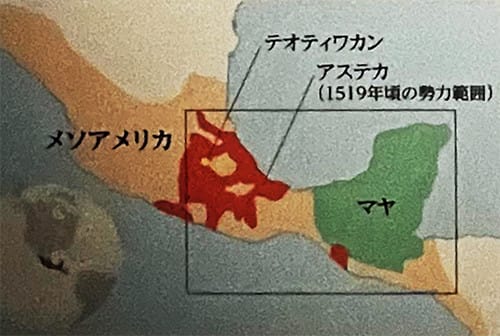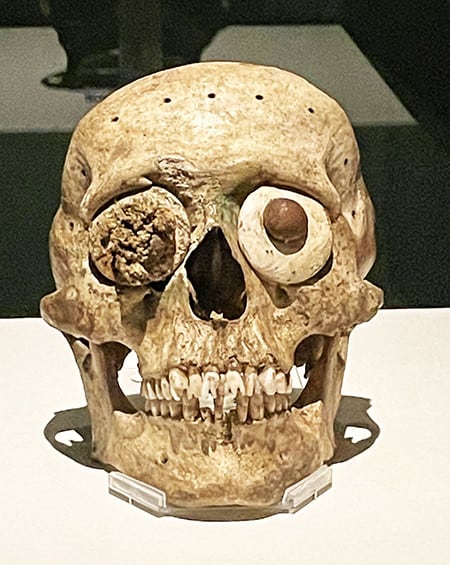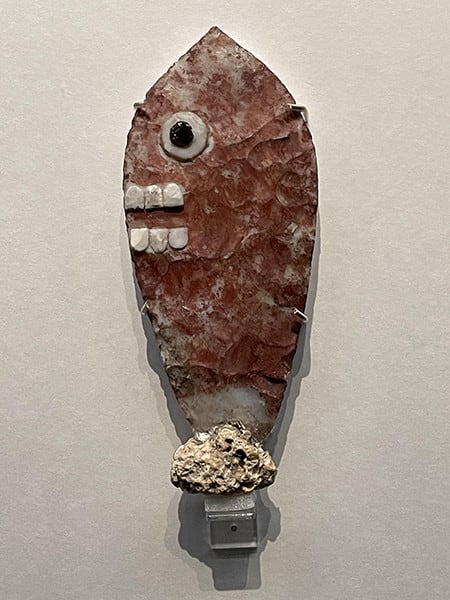

さて古代メキシコの東京国立博物館での特別展からの民族性探究、テオティワカン文化の地域に後継的に出現したアステカ文化についてであります。名前から刷り込まれているイメージはもっとも武闘派のイメージ。
実際にはその成立は1428年頃からスペインによる侵攻によって滅亡する1521年までの約95年間というメキシコ中央部に栄えたメソアメリカ文明の国家。この時期は日本では戦国期のまっ盛りということになる。言ってみれば戦国最大の軍事地域国家・甲斐武田氏みたいなイメージと思える。
日本中央地域を抑えた織田政権は堺からの貿易によって軍事力を近代化して征服地域を圧倒的に拡大していったけれど、甲斐武田氏は、地理的にその兵器近代化競争で後れを取って滅亡した。まぁディテールを端折って巨視的に見ればこういう把握がふさわしいと思える。
どうも、スペインの侵略に潰滅させられたというアステカの運命が重なって見える気がします。
いちばん上の神殿は石造。太陽神信仰らしくひとびとの目線の高台から託宣するような舞台装置。


かれらの宗教儀式に於いては、くりかえし「生け贄」が捧げられ、その頭蓋が聖なるモノとして供されていた。人間の臓器や部位が取り上げられて神に捧げられる儀式が延々と行われる。その下の写真は聖なるナイフとされている。ナイフにまるで人格が付与されているようなデザイン。このような宗教儀式のスタイルを見て、近代人としてのスペイン人たちはその宗教的な距離感に恐怖観念を植え付けられただろうことも容易に想像できる。
しかしアステカの軍事力は主たる武器は石器が使われ、かろうじて青銅器もあったという段階。鉄器の利用はなかったと言われている。鋭利な鉄器と飛び道具としての鉄砲銃器で武装したスペインの近代軍には為す術はなかった。
この点ではむしろ、鉄器生産では弥生期からの歴史があり、そして銃器も国内で生産されていた戦国のニッポンは、世界史的にも珍しい非西欧国家だったのだとも言える。接触した西洋人たちは鉄砲が輸入されると瞬く間に国内生産されていく様子を見て、その技術力に驚愕しただろうことも想像できる。
すくなくとも鉄器については中国大陸で独自に開発され、その利器を獲得するために古代日本国家は朝鮮半島の政治情勢にも深く関与し、やがて国産するに至る歴史過程を持っている。同時代に、他の文明地域との交流が叶わなかったアステカ、中央アメリカ地域の特殊性ということが出来るだろうか。
そういう意味では人類グレートジャーニーの最終地域に近く、人間痕跡の積層からの隔絶がかれらの悲劇に結びついていったのかも知れない。
English version⬇
The Aztec Culture of the Warring States Aztecs, similar to the Takeda Clan of Warring States, Ancient Mexico-8
The Aztecs' religious rituals and military organization were extremely militant, but their weapons were stone tools and bronze tools. Did the Western Spanish fear this culture and eliminate it? ...
This is an ethnographic exploration of ancient Mexico from a special exhibition at the Tokyo National Museum on the Aztec culture that emerged as a successor to the Teotihuacan culture in the region. The image imprinted by the name is that of the most martial people.
In reality, the Aztecs were a Mesoamerican civilization that flourished in central Mexico for about 95 years, from around 1428 until their destruction by the Spanish invasion in 1521. This period was the height of the Warring States period in Japan. In other words, it is like the Kai Takeda clan, the largest military regional state in the Warring States period.
While the Oda regime, which controlled the central region of Japan, modernized its military power through trade from Sakai and expanded its conquests overwhelmingly, the Kai Takeda clan fell behind in the race to modernize its weaponry due to its geographical location and perished. Well, if we look at it from a macroscopic point of view without going into details, this seems to be an appropriate way to understand the situation.
I feel that the fate of the Aztecs seems to overlap with the fate of the Aztecs, who were crushed by the Spanish invasion.
The top temple is made of stone. It is a stage set up as if it were an oracle from a height above the people's eye level, as is typical of the belief in the sun god.
In their religious ceremonies, "sacrifices" were made repeatedly, and the skull was offered as a sacred object. The rituals in which human organs and parts were taken away and offered to the gods went on and on. The picture below is supposed to be a sacred knife. The design makes it look as if the knife has been given a personality. It is easy to imagine that the Spaniards as modern people would have been instilled with a fearful notion of religious distance by seeing this style of religious rituals.
However, Aztec military power was at a stage where stone tools were used as the primary weapons, and there were barely any bronze weapons. It is said that there was no use of iron weapons. They were no match for the modern Spanish army, which was armed with sharp-edged iron weapons and firearms as leapfrogs.
In this respect, it can be said that Japan, which had a history of iron production since the Yayoi period and produced firearms domestically during the Warring States period, was a non-Western nation, which is rare in the history of the world. One can imagine that Westerners who came into contact with Japan must have been astonished at the technological capabilities of the country when they saw how guns were produced domestically in the blink of an eye after they were imported.
At the very least, iron weapons were developed independently in mainland China, and in order to acquire such weapons, the ancient Japanese nation became deeply involved in the political situation on the Korean peninsula and eventually produced them domestically. The Aztecs and Central Americans were not able to communicate with other civilizations in the same period, and this could be seen as a peculiarity of the region.
In this sense, the Aztecs were close to the final region of the Great Journey of mankind, and their isolation from the layers of human traces may have led to their tragedy.










